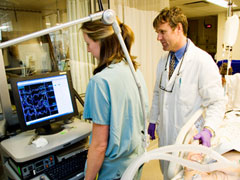It Just Clicked
By Laura Pratt
Dr. David Houlden heard it before anyone else did. It was the sound of possibility, and listening to it actually cost him some of the hearing in his left ear. No big deal, says Houlden, an associate scientist in clinical integrative biology at Sunnybrook Research Institute who’s thrilled that the work he pioneered in the late 1990s on diagnosing previously “undiagnosable” balance problems is now being heard.
There are two major balance organs in the ear: the semicircular canals and the saccules. The former measure angular accelerations—like tilting in an airplane or riding on a roller coaster; the latter gauge linear accelerations, like speeding up on a train. There are, says Houlden, excellent tests for determining whether a person’s unsteady handle on angular acceleration is at the root of a balance problem (doctors put water in the ears and look for corresponding eye movements, an indication of functioning canals), but not for exploring the saccule’s role, and whether linear acceleration issues are to blame for compromised equilibrium. “Consequently,” says Houlden, “someone could be losing their balance and get normal [results] on a semicircular canal test.”
In the vestibular evoked myogenic potential (VEMP) test, the surprising connection between a person’s neck reflexes and the inner ear is exploited. Inside a prescribed time window, a click to the ear should evoke a corresponding twitch in the neck muscles of a person with healthy saccules. “You don’t even think about this thing,” says Houlden. “It’s hard-wired, like the reflex after a tap to the knee.”
Just the same, says Houlden, who suffered some hearing loss years ago from an especially lengthy test session on himself (“We learned something,” he shrugs), this link was not discovered earlier because no one was looking for it. “Who would think a click could cause a postural reflex? It would be like saying, “Let’s stimulate sight with temperature.”
Houlden and his team weren’t the first to develop a test for measuring the saccule’s aptitude. They were picking up on work done almost 40 years ago that had been set aside because of problems with the research. “The origins of the response were not well understood, the recordings weren’t consistent, the effect of background muscle activity was not understood, and many different stimuli could evoke similar responses,” Houlden says. “It was abandoned.”
Houlden revived it in the early 1990s—he was the first to isolate the response correctly—and now, he marvels, the rest of the world is perking up its ears. “This is really hot now. We’re looking back at our history and saying, ‘Maybe we were onto something.’”
Up next? Efforts to standardize the test are undermined by varying amounts of neck muscle contraction (voluntarily produced during the test) that increase the variability of the reflex. Consequently, Houlden—the only continuing investigator from the earlier research stint—and collaborators, Dr. Joseph Chen (a Sunnybrook ear, nose and throat [ENT] surgeon), Dr. Wei Xian (an ENT research fellow), Dr. Farhad Pirouzmand (a Sunnybrook neurosurgeon) and Dr. Heng-Wai Yuen (an otology fellow) are testing a chin-rest device that gives the subject feedback about the level of neck muscle contraction.
On top of that, these Sunnybrook researchers are working to understand better the origin and neurophysiology of the reflex by stimulating the saccule directly during surgery. This way, says Houlden, “We can make sure the results from the click test in the clinic correlate exactly to what we find when we stimulate the saccule [surgically]. Then we can be confident that the two are linked. For me, that’s quite satisfying.”
PDF / View full media release »





